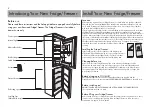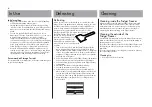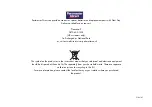
In Use
Defrosting
Cleaning
6
Label everything
• Many foods look the same when frozen, so careful labelling
will help avoid forgetting what an item is.
• Storage times being exceeded could cause food poisoning.
or home cooked food add the date as you will then be able to
make sure you don’t eat food past the recommended storage
period.
• You can buy special Fridge/Freezer tape for use in low
temperatures. This tape is available in white, so you can use it
to write the items contents on. You can buy special
Fridge/Freezer labels and pens. Labels come in different
colours which can help you use your Fridge/Freezer effectively.
For instance you could colour code meat red and vegetables
green. Using a different colour label for each quarter of the
year will help you rotate your frozen food more efficiently.
• Write the contents and date. Add the weight and notes on
cooking such as ‘thaw first’, or ‘cook from frozen’ and keep a
separate ‘log-book’ of what is in each drawer. This will save
opening the door and searching around unnecessarily.
Recommended Storage Periods
For recommended food storage time, refer to the information given
on your food packaging.
Defrosting
After a period of time frost will build up in certain areas in the
Fridge/Freezer compartment. As a temporary measure, this frost
should be scraped away using a plastic scraper. NEVER use a
metal or sharp instrument. Complete defrosting will however
become necessary approximately once per year, or if the
frost layer exceeds 5mm to maintain the efficiency of
the Fridge/Freezer. This should be
carried out if the frost build-up
cannot be scraped away, or if it
begins to interfere with the food
storage. Choose a time when the
stock of frozen food is low and proceed
as follows:
1 Take out the frozen food, turn the Fridge/Freezer off at the
mains supply and leave the doors open. Ideally the frozen
food should be put into another Fridge/Freezer or refrigerator.
If this is not possible wrap the food, firstly in several sheets of
newspaper or large towels and then in a thick rug or blanket
and keep it in a cool place.
2 Pull out the bottom drawer of the Fridge/Freezer compartment
and open the water drain cover at the back of the drawer.
3 Pull out the drain plug from the bottom of the Fridge/Freezer
compartment.
4 Place the water drain cover beneath the drain plug.
5 Pour away the water as it melts into the drawer.
6 Scrape away as much frost build-up as possible using the
plastic scraper. To accelerate the thawing process place bowls
of hot water inside the Fridge/Freezer cabinet. As the solid
frost loosens, prize it away with the plastic scraper and remove.
7 When defrosting is completed, clean your Fridge/Freezer
as described.
.
Cleaning inside the Fridge/Freezer
After defrosting you should clean the Fridge/Freezer internally
with a weak solution of bicarbonate of soda. Then rinse with
warm water using a ‘wrung-out’ sponge or cloth and wipe dry.
Wash the baskets in warm soapy water and ensure they are
completely dry before replacing in the Fridge/Freezer.
Cleaning the outside of the
Fridge/Freezer
Use standard furniture polish to clean the Fridge/Freezer exterior.
Make sure that the doors are closed, to prevent polish getting on
the magnetic door seal or inside.
The grille of the condenser at the back of the Fridge/Freezer and
the adjacent components can be vacuumed using a soft brush
attachment.
Do not use harsh cleaners, scouring pads or solvents to clean any
part of the Fridge/Freezer
Cleaning tip
• Defrost when food stocks are low.





























